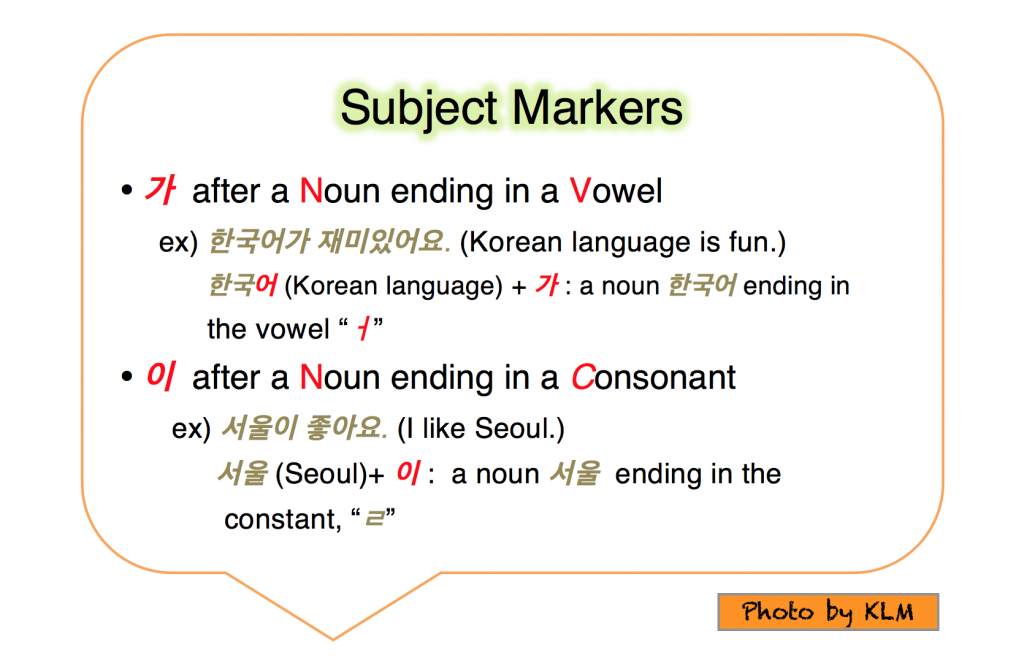What Is a Subject Marking Particle? Posted by Kyung-Hwa on May 3, 2017 in Grammar, Korean Language, Vocabulary
Have you ever wondered about the small words, 이/가, 은/는, or 을/를 in the Korean language? They are particles that mark a subject, topic, or object in a sentence. In this post, we will explore the subject markers, 이 and 가 in Korean.

For examples, the particle “off” from the phrasal verb “call off (cancel)” has little or no meaning by itself: A particle’s function is to express a grammatical relationship with other words or phrases. It needs to be associated with other words to bestow meaning. Korean language also has particles that serve grammatical functions in sentences. Today, we will explore how to use Korean subject markers, 이 and 가. They are attached to nouns and indicate which nouns are the subjects of the verbs, which describe an action or a state of being. You add 가 to a noun when the noun ends in a vowel, and 이 to a noun when the noun ends in a consonant.
♣ Noun ending in a Vowel + 가
- 갈비가 맛있어요. (Kalbi is delicious.)
갈비 (Kalbi) + 가 : a noun 갈비 ending in the vowel, “ㅣ”
- 커피가 있어요. (I have coffee.)
커피 (coffee) + 가 : a noun 커피 ending in the vowel “ㅣ”
- 알렉스가 한국에 왔어요. (Alex came to Korea.)
알렉스 (Alex) + 가 : a noun 알렉스 ending in the vowel “ㅡ”
- 한국어가 재미있어요. (Korean language is fun.)
한국어 (Korean language) + 가 : a noun 한국어 ending in the vowel “ㅓ”
♣ Noun ending in a Consonant + 이
- 돈이 없어요. (I don’t have money.)
돈 (money)+ 이 : a noun 돈 ending in the consonant, “ㄴ”
- 가족이 미국에 있어요. (My family is in America.)
가족 (family)+이 : a noun 가족 ending in the consonant, “ㄱ”
- 설탕이 필요해요. (I need sugar.)
설탕 (sugar)+ 이 : a noun 설탕 ending in the constant, “ㅇ”
- 서울이 좋아요. (I like Seoul.)
서울 (Seoul)+ 이 : a noun 서울 ending in the constant, “ㄹ”
The subject markers, 이 and 가 are small words, and you will be able to communicate with native Koreans without them. For example, Koreans would still understand your comment such as, “돈 없어요. (I don’t have money.) instead of “돈이 없어요. (I don’t have money.)” However, they will help deliver your message in a clearer way. Just remember the following two rules when you add 이 and 가 to the nouns:
- 가 after a Noun ending in a Vowel
- 이 after a Noun ending in a Consonant
감사합니다! (Thank you!)
***Related Vocabulary***
- (Noun ending in a Vowel +) 가
- (Noun ending in a Consonant +) 이
- 갈비 (Kalbi)
- 커피 (coffee)
- 한국 (Korea)
- 한국어 (Korean language)
- 돈 (money)
- 가족 (family)
- 미국 (America)
- 설탕 (sugar)
- 서울 (Seoul)

Build vocabulary, practice pronunciation, and more with Transparent Language Online. Available anytime, anywhere, on any device.




Comments:
크리스틴:
This is so nice for me…I learn how to speak korean i saw this…
Kyung-Hwa:
@크리스틴 I am glad to hear that this post was helpful to you *^^*
감사합니다!
Lauryn Fann:
Hello, Kyung-Hwa, I was wondering what else would really help me grasp this because I am having trouble. I have no experience what so ever. So if you like know websites and/or app that should help could u take the time to reply. Thanks.
Kyung-Hwa:
@Lauryn Fann 안녕하세요,
Thank you very much for your comment.
I hope this YouTube video would help your understanding on subject markers along with object and topic markers.
https://youtu.be/M51VVMoAa6g
Please hang in there. Once I complete my series of Korean particles, you will have a better idea of their differences.
(As mentioned in my post, Korean people will be able to understand your comment without these particles.)
감사합니다 *^^*
frankie:
Do we always use topic/subject marking particles in every word?
Kyung-Hwa:
@frankie 안녕하세요. (Hello.)
As I mentioned in my post “What Is a Topic Marking Particle?”, Korean people will still understand your comment without these markers. However, using these markers will help you to deliver your message in a clearer way, especially in your writing.
감사합니다! (Thank you!)
frankie:
@Kyung-Hwa thank you so much